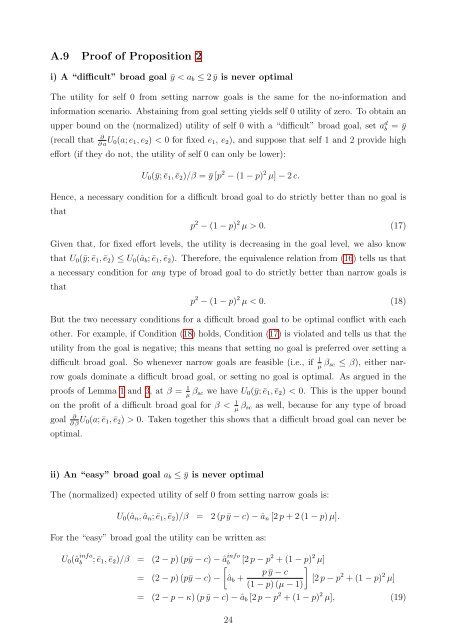Motivational Goal Bracketing - School of Economics and ...
Motivational Goal Bracketing - School of Economics and ...
Motivational Goal Bracketing - School of Economics and ...
Create successful ePaper yourself
Turn your PDF publications into a flip-book with our unique Google optimized e-Paper software.
A.9 Pro<strong>of</strong> <strong>of</strong> Proposition 2<br />
i) A “difficult” broad goal ¯y < ab ≤ 2 ¯y is never optimal<br />
The utility for self 0 from setting narrow goals is the same for the no-information <strong>and</strong><br />
information scenario. Abstaining from goal setting yields self 0 utility <strong>of</strong> zero. To obtain an<br />
upper bound on the (normalized) utility <strong>of</strong> self 0 with a “difficult” broad goal, set ad b = ¯y<br />
(recall that ∂<br />
∂ aU0(a; e1, e2) < 0 for fixed e1, e2), <strong>and</strong> suppose that self 1 <strong>and</strong> 2 provide high<br />
effort (if they do not, the utility <strong>of</strong> self 0 can only be lower):<br />
U0(¯y; ē1, ē2)/β = ¯y [p 2 − (1 − p) 2 µ] − 2 c.<br />
Hence, a necessary condition for a difficult broad goal to do strictly better than no goal is<br />
that<br />
p 2 − (1 − p) 2 µ > 0. (17)<br />
Given that, for fixed effort levels, the utility is decreasing in the goal level, we also know<br />
that U0(¯y; ē1, ē2) ≤ U0(âb; ē1, ē2). Therefore, the equivalence relation from (16) tells us that<br />
a necessary condition for any type <strong>of</strong> broad goal to do strictly better than narrow goals is<br />
that<br />
p 2 − (1 − p) 2 µ < 0. (18)<br />
But the two necessary conditions for a difficult broad goal to be optimal conflict with each<br />
other. For example, if Condition (18) holds, Condition (17) is violated <strong>and</strong> tells us that the<br />
utility from the goal is negative; this means that setting no goal is preferred over setting a<br />
difficult broad goal. So whenever narrow goals are feasible (i.e., if 1<br />
µ βsc ≤ β), either narrow<br />
goals dominate a difficult broad goal, or setting no goal is optimal. As argued in the<br />
pro<strong>of</strong>s <strong>of</strong> Lemma 1 <strong>and</strong> 3, at β = 1<br />
µ βsc we have U0(¯y; ē1, ē2) < 0. This is the upper bound<br />
on the pr<strong>of</strong>it <strong>of</strong> a difficult broad goal for β < 1<br />
µ βsc as well, because for any type <strong>of</strong> broad<br />
goal ∂<br />
∂ β U0(a; ē1, ē2) > 0. Taken together this shows that a difficult broad goal can never be<br />
optimal.<br />
ii) An “easy” broad goal ab ≤ ¯y is never optimal<br />
The (normalized) expected utility <strong>of</strong> self 0 from setting narrow goals is:<br />
U0(ân, ân; ē1, ē2)/β = 2 (p ¯y − c) − ân [2 p + 2 (1 − p) µ].<br />
For the “easy” broad goal the utility can be written as:<br />
U0(â info<br />
b ; ē1, ē2)/β = (2 − p) (p¯y − c) − â info<br />
b [2 p − p 2 + (1 − p) 2 =<br />
µ]<br />
<br />
<br />
p ¯y − c<br />
(2 − p) (p¯y − c) − âb +<br />
[2 p − p<br />
(1 − p) (µ − 1)<br />
2 + (1 − p) 2 µ]<br />
= (2 − p − κ) (p ¯y − c) − âb [2 p − p 2 + (1 − p) 2 µ], (19)<br />
24
















